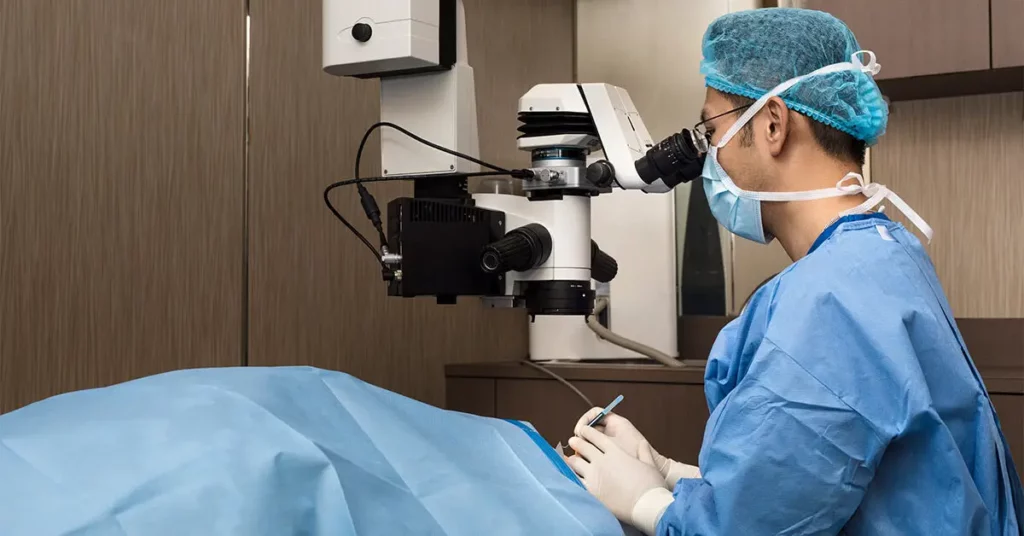Laser eye surgery offers a convenient and long-lasting solution to correct your vision. And two most popular options are Femto LASIK and Smile LASIK, both of which utilize advanced laser technology to reshape the cornea and improve your eyesight. In this blog post, we will examine and discuss the distinctions between Femto LASIK and Smile LASIK and provide you with valuable insights that will assist you in making an informed decision regarding which procedure is most suitable for your individual needs.
Contents
What is Femto LASIK?
Femto LASIK also referred to as Femtosecond LASIK, is an advanced technique in laser eye surgery utilized to correct refractive errors including nearsightedness, farsightedness, and astigmatism. It is a variation of the traditional LASIK procedure that incorporates femtosecond laser technology for enhanced precision and safety.
Femto LASIK has gained popularity as a safe and effective procedure for vision correction, providing patients with clearer vision and decreased dependence on glasses or contact lenses.
During Femto LASIK, the surgeon uses a femtosecond laser to create a thin, hinged flap on the cornea’s outer layer. The surgeon lifts this flap to expose the underlying corneal tissue and uses an excimer laser to reshape the cornea, correcting the refractive errors and improving vision. Afterward, the flap is repositioned, naturally adhering without the need for stitches.
Exploring Smile LASIK
Smile LASIK, short for Small Incision Lenticule Extraction, is an innovative laser eye surgery technique that offers an alternative to traditional LASIK and Femto LASIK. Let’s delve into the details and discover more about this exciting procedure:
How Smile LASIK Works: Smile LASIK is a flapless and minimally invasive procedure that corrects refractive errors by reshaping the cornea. Here’s an overview of the process:
- Creation of Lenticule: A femtosecond laser is used to create a thin, disk-shaped lenticule within the cornea. This lenticule contains the precise amount of tissue that needs to be removed to correct the refractive error.
- Small Incision: The surgeon then makes a small incision, typically around 2-4 mm, on the cornea’s surface.
- Lenticule Extraction: Through the incision, the surgeon removes the lenticule, which reshapes the cornea and corrects the refractive error.
- Corneal Remodeling: The removal of the lenticule changes the cornea’s curvature, allowing light to properly focus on the retina and improving vision.
Key Differences between Femto and Smile LASIK
Femto LASIK and Smile LASIK are two widely recognized laser eye surgery procedures that are specifically designed to correct refractive errors and enhance vision. However, there are significant differences between the two techniques. Here are the key distinctions to consider when comparing Femto LASIK and Smile LASIK:
Surgical Techniques
- Femto LASIK: In Femto LASIK, a femtosecond laser is used to create a thin corneal flap, which is lifted to allow access to the underlying cornea for reshaping.
- Smile LASIK: Smile LASIK is a flapless procedure. Using a femtosecond laser, a small incision is made on the cornea in Smile LASIK instead of creating a flap. The surgeon then removes a precise, lenticular-shaped piece of corneal tissue through the incision to reshape the cornea.
Corneal Incision Size
- Femto LASIK: The creation of a corneal flap in Femto LASIK typically requires a larger incision compared to Smile LASIK.
- Smile LASIK: The incision made in Smile LASIK is smaller, which may result in less disruption to the corneal biomechanics and potentially faster healing.
Recovery Time and Discomfort
- Femto LASIK: The recovery time after Femto LASIK is generally relatively quick, with most patients experiencing improved vision within a day or two. However, it may take a few weeks for the corneal flap to fully heal.
- Smile LASIK: Smile LASIK typically offers a faster recovery time compared to Femto LASIK. Many patients notice improved vision within a day, and the absence of a corneal flap can contribute to a potentially quicker healing process.
Vision Correction Range
- Femto LASIK: Femto LASIK is suitable for correcting a wide range of refractive errors, including myopia (nearsightedness), hyperopia (farsightedness), and astigmatism.
- Smile LASIK: While Smile LASIK is effective for treating myopia, it may have limitations when it comes to treating astigmatism or hyperopia. Patients with mild to moderate myopia are the right candidate for this.
Corneal Integrity
- Femto LASIK: The creation of a corneal flap in Femto LASIK may involve a larger area of the cornea, potentially affecting its overall structural integrity.
- Smile LASIK: Smile LASIK preserves a larger portion of the cornea’s structural integrity since it does not require a corneal flap. This may be advantageous for individuals with thinner corneas or those engaged in high-impact activities.
Potential Considerations for Femto LASIK and Smile LASIK
 While Femto LASIK and Smile LASIK offer effective solutions for vision correction, it is essential to consider certain factors before deciding on the most suitable procedure. Here are some potential considerations for both Femto LASIK and Smile LASIK:
While Femto LASIK and Smile LASIK offer effective solutions for vision correction, it is essential to consider certain factors before deciding on the most suitable procedure. Here are some potential considerations for both Femto LASIK and Smile LASIK:
Femto LASIK Considerations:
- Corneal Flap: The creation of a corneal flap in Femto LASIK involves a larger incision, which may slightly increase the risk of flap-related complications compared to Smile LASIK.
- Corneal Integrity: If you have a thinner cornea, Femto LASIK may involve a greater alteration to the corneal structure due to the larger corneal flap, which could impact corneal integrity.
- Recovery Time: While Femto LASIK generally offers a quick recovery, it may take a few weeks for the corneal flap to fully heal.
- Suitability for Astigmatism: Femto LASIK is effective for correcting astigmatism; however, the degree of astigmatism and other individual factors may influence the overall success and predictability of the procedure.
Smile LASIK Considerations:
- Refractive Error Range: Individuals with mild to moderate myopia (nearsightedness) can be the ideal candidate for SMILE. So, if you have significant hyperopia (farsightedness) or astigmatism, Smile LASIK may not be the ideal procedure for your vision correction.
- Availability: Smile LASIK may not be as widely available as Femto LASIK in all regions or eye clinics. Therefore, it is important to ensure that your preferred eye care provider offers Smile LASIK as an option.
- Limitations of the Procedure: Smile LASIK has demonstrated excellent outcomes in correcting myopia; however, its effectiveness in correcting astigmatism and hyperopia may be limited when compared to Femto LASIK.
- Experience of Surgeon: Choosing a skilled and experienced surgeon is paramount when considering Smile LASIK. Therefore, select a well-trained surgeon who can perform the surgery efficiently.
Which Surgery Is Right For You?
 Choosing the most suitable laser eye surgery procedure, whether Femto LASIK or Smile LASIK, depends on various factors specific to your individual vision needs and eye health. To determine which surgery is right for you, consider the following aspects:
Choosing the most suitable laser eye surgery procedure, whether Femto LASIK or Smile LASIK, depends on various factors specific to your individual vision needs and eye health. To determine which surgery is right for you, consider the following aspects:
- Consultation with an Eye Care Professional: Schedule a consultation with a qualified eye care professional. They will assess your eye health, perform a comprehensive examination, and discuss your vision goals to recommend the most appropriate procedure.
- Refractive Error and Eye Condition: Your refractive error plays a significant role in determining the ideal surgery. In determining the best option for you, the eye care professional will take into account the severity of your refractive error. Femto LASIK suits a wide range of refractive errors, while Smile LASIK primarily recommends mild to moderate myopia correction.
- Corneal Thickness: The thickness of your cornea is an important consideration. If you have a thin cornea, Smile LASIK may be a more suitable choice as it preserves more of the corneal integrity compared to Femto LASIK.
- Lifestyle and Activities: If you participate in contact sports or activities that may pose a higher risk of eye trauma, Smile LASIK’s flapless approach might be preferable. On the other hand, if you have specific career requirements or preferences, discuss these with your eye care professional to determine which surgery aligns better with your lifestyle.
- Risk Tolerance and Personal Preference: Femto LASIK and Smile LASIK have different surgical techniques and recovery experiences. Research and discuss these aspects with your eye care professional to ensure you choose the procedure that aligns with your preferences and risk tolerance.
- Patient Testimonials and Surgeon Experience: Read patient testimonials and reviews to gain insights into other individuals’ experiences with each procedure. Additionally, consider the experience and expertise of the surgeon performing the surgery.
Conclusion
In conclusion, when deciding between Femto LASIK and Smile LASIK for vision correction, it is important to consider factors such as your refractive error, corneal thickness, recovery time, and lifestyle. Consulting with an experienced eye care professional is crucial to make an informed decision that aligns with your specific needs. Keep in mind that each individual’s situation is unique and personalized advice from a qualified professional is essential in determining which surgery is the right choice for you.
EyeMantra offers the most advanced LASIK options including PRK, Femto Lasik, SMILE surgery, Standard LASIK, ICL, and Contoura vision. If you have any questions on Lasik surgery in Delhi, Lasik surgery cost, and Lasik procedure, call us at 9711116605 or email at [email protected].


